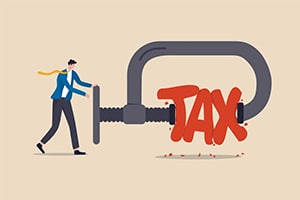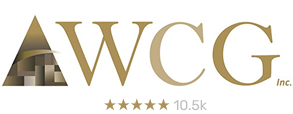
Business Advisory Services
Everything you need to help you launch your new business entity from business entity selection to multiple-entity business structures.
Hey - Our site just had a makeover and we are sorting through the hiccups!
Hey - Our site just had a makeover and we are sorting through the hiccups!

Everything you need to help you launch your new business entity from business entity selection to multiple-entity business structures.

Designed for rental property owners where WCG CPAs & Advisors supports you as your real estate CPA.

Everything you need from tax return preparation for your small business to your rental to your corporation is here.

WCG’s primary objective is to help you to feel comfortable about engaging with us
Table Of Contents

Update April 3, 2020 at 10:51AM suffering from mojitovirus (added quick thoughts, see below).
The CARES Act was just signed into law on Friday, March 27 and it included a crazy SBA loan called the Paycheck Protection Program (PPP). We wrote about this in another blog post titled COVID-19 Tax Stimulus but we wanted to take the SBA PPP loan and expand considerably on it. WCG has applied for this loan ourselves since our ability to predict our future is gone like most small businesses. We are a super healthy firm, but we are also very cautious and methodical with our operations.
As such, we will be able to do two things: first, help you complete the necessary forms and schedules for SBA’s Paycheck Protection Program, and second, give you our first-hand account of the process.
We encourage you to come back to this post often as we receive further guidance. Here we go-
This thing is a mess! The rules have been changing throughout the week. Here are some quick thoughts-
The SBA funded $28 billion in loans in 2019. They are now expected to fund $349 billion in a day… a week… a month. Mission impossible.
Banks are not thrilled to be doing this. They must use their own capital and get paid 1%. Yuck. They won’t get a return of capital until the forgiveness component is completed. So they have a ton of risk. Banks are only backstopped 75%, and even that is flimsy. If a box isn’t checked correctly… if the loan application was processed incorrectly… the SBA says “too bad so sad, no backstop for you!” So, low rates of return, reliance on forgiveness for return of capital and a 75% backstop. Not good.
Bank of America is the first big bank to go through this. Marketing ploy? Did Treasury ask them to test the system, and did BofA say Sure, we’ll lose money but we’ll gain some marketing exposure?
Big banks operate on way tighter capital margins than local banks which is another reason they are not thrilled. For example, WCG has a relationship with Wells Fargo and Chase (and our amazing First National Bank of Monument). Both big banks have a silly online questionnaire which ends in a “we’ll get back to you in a few days.” Seems cavalier if the pool of money is being drained like Caddyshack. Lesson here: bank with a community bank and build those relationships for moments like these!
So, let’s break this down. The CARES Act vis-a-vis the SBA is telling banks to lend money to businesses most impacted by coronavirus with nearly no upside potential and a lot of downside problems. No collateral. No personal guarantees. Use bank capital. Low interest rate (below risk free rate of return). Put money in the hands of high-risk businesses some of which were already in the fray. Backstopped at 75% by the SBA. Why the heck would banks want to do this? They don’t. Many see it as a way to shore up their own client base, but even that has major league risks.
We are also seeing a lot of banks dramatically increase their underwriting; they ask a few basic questions to make you feel like “you’ve applied” but then they ask for a lot of data to ensure your credit worthiness. Also, several banks are simulating the forgiveness component so they can assess the remaining loan, and eventually the bank’s risk of both (forgiveness amount and remainder against your creditworthiness).
As a quick funny, we now have our own version of Sooners… people sneaking across the Oklahoma state line to run out there and stake their claim before the land rush. Small business owners lining up to grab their PPP dollars like a race. PPP Sooners. We’re gonna sell T Shirts. “Daddy, tell me about PPP Sooners one more time before bed.” “Sure son. Was the dark of the moon on the sixth of June in a Kenworth pullin’ logs. Cab-over Pete with a reefer on and a Jimmy haulin’ hogs.” Wait, that’s a song.
As mentioned in another blog post, the CARES Act includes a $350 billion loan program titled Paycheck Protection Program for businesses with fewer than 500 employees (including sole proprietors, independent contractors and anyone otherwise self-employed). Under the bill, entities can use the funds to make payroll and cover other expenses, including rent, utilities, mortgage interest and interest on other debt obligations, from February 15, 2020, to June 30, 2020. Eligible entities may borrow up to $10 million, based on a formula tied to 2.5 times average monthly payroll, covering employees making up to $100,000 per year. A loan forgiveness component exists and is based on certain amounts spent for an eight-week period. Don’t worry, we’ll go into detail on PPP forgiveness since that is a major benefit of this loan.
Quick stats-
Here is a laundry list of businesses that are eligible for the SBA loan-
Most of these are straightforward. A few comments however…
The 500-employee threshold includes full-time and part-time employees including seasonal.
Number 2 above is interesting since the SBA also may consider a business small based on sales for a particular industry. For example, NAICS code 112310 Chicken Egg Production is deemed a small business if sales are $16.5 million or less.
Of course 4, 5 and 6 are awesome because it specifically calls out sole proprietors, independent contractors and self-employed people who otherwise might not have employees.
NAICS 721 (Accommodations) and 722 (Food Services and Drinking Places) use the 500-employee threshold on a per physical location basis.
Small businesses must provide a good faith certification that-
For WCG… and for many small businesses, the first certification is the basis for the loan in general. Predictive qualities of the future simply do not exist right now. As of March 28, mortgage rates are all over the map and jumbo loans (above $510,000) cannot even be quoted.
As conversation fodder and in relation to number 1 above, consider the possible bookends-
Where do you fall? Probably right between smack and dab.
As stated above, eligible businesses may borrow up to $10 million, based on a formula tied to 2.5 times average monthly payroll, covering employees making up to $100,000 per year.
Quick basics- Your loan amount is purely based on payroll costs. Your forgiveness amount is based on payroll costs in addition to mortgage loan interest, rent and utilities.
Another way to look at this is… 2.5 x monthly payroll is essentially 10.75 weeks of payroll costs. We’ll talk about how this factors into loan forgiveness in a bit.
However, according toTreasury’s PPP Fact Sheet, there is wording like this, “Loans can be for up to two months of your average monthly payroll costs from the last year plus an additional 25% of that amount.” This is the same as 2.5 x monthly average. Not sure why they complicated it. 25% of 2.0 is 0.5. $100,000 x 2.5 is $250,000. $100,000 x 2 is $200,000 plus 25% is $250,000. Ugh!
What is considered payroll? According to the code-
(aa) the sum of payments of any compensation with respect to employees that is a—
(AA) salary, wage, commission, or similar compensation;
(BB) payment of cash tip or equivalent;
(CC) payment for vacation, parental, family, medical or sick leave;
(DD) allowance for dismissal or separation;
(EE) payment required for the provisions of group health care benefits, including insurance premiums;
(FF) payment of any retirement benefit; or
(GG) payment of State or local tax assessed on the compensation of employees; and
(bb) the sum of payments of any compensation to or income of a sole proprietor or independent contractor that is a wage, commission, income, net earnings from self-employment or similar compensation and that is in an amount that is not more than $100,000 in 1 year, as prorated for the covered period;
Under (aa)(EE) the code uses the term group health care benefits, however a sole proprietor typically does not have group health care. In addition, even a small business employee beyond the owner might have health insurance coverage that does not technically qualify as group health care. Also, does this include other employee benefits such as sort-term and long-term disability, or group life insurance?
As a materially participating S Corp shareholder you are also an employee, so you would fit into the (AA) above. However, the (BB) section only mentions sole proprietor or independent contractor; as such we do not think you can consider net ordinary business income or shareholder distributions with respects to an S corporation… just W-2 wages paid to you capped at a $100,000. A few of you are kicking yourselves for keeping salary so low… but you might be able to amend prior payrolls before filing 2020 Q1 payroll filings.
Under (aa)(GG), payment of state or local tax assessed on the compensation, employees would include state unemployment insurance benefits. Another example here in Colorado is Denver’s employee tax. It is a tax that is assessed versus withheld… so state income taxes withheld do not count (which makes sense since it is already inclusive in the employee’s wages).
Under (bb), this is a conundrum since self-employed business owners want to minimize taxes and they might have made decisions in 2019 to use bonus depreciation or other deductions to dramatically reduce their net income. Now good tax planning might be coming back to bite them in the butt.
We’ve been getting a lot of correspondence asking about contractors that you pay. By definition contractors are not employees, so our response as we see it is No. But! Look at the code above, there is a sneaky “and” at the end of (GG) under (aa) so it appears to also include contractors. Upon more reflection, this simple includes self-employment income into the definition of “payroll costs” so those individuals can also obtain their own SBA loan under this program.
Some business owners are arguing that they will have to “layoff” contractors if those payments are not included in the loan amount calculation. However, keep in mind that contractors as self-employed business owners are eligible for the PPP loan. Therefore, given their uncertainty based on your uncertainty, they can obtain SBA funds.
And this would be a double-dip. You would get “credit” for the amount paid to contractors when calculating your loan amount… and the the contractor could also get a similar loan based on the same dollar. Said in another way; the same dollar could be leveraged for an SBA PPP Loan by company ABC who issued a 1099 to company XYZ. Seems like a No No to us. But we didn’t write the code. We’ll have to wait and see on that.
Consider this: you 1099 us, and we 1099 you. That is a net-zero transaction from an income tax perspective, but we just created PPP dollars. Insane! The Treasury’s guidelines released on Thursday, April 2, say No.
Ok, so we know what is allowed… what is not allowed to be included? Straight from the code-
(aa) the compensation of an individual employee in excess of an annual salary of $100,000, as prorated for the covered period;
(bb) taxes imposed or withheld under chapters 21, 22 or 24 of the Internal Revenue Code of 1986 during the covered period;
(cc) any compensation of an employee whose principal place of residence is outside of the United States;
(dd) qualified sick leave wages for which a credit is allowed under section 7001 of the Families First Coronavirus Response Act (Public Law 116–127); or
(ee) qualified family leave wages for which a credit is allowed under section 7003 of the Families First Coronavirus Response Act (Public Law 116–127); and
How about some explanation? Chapter 21 refers to Social Security and Medicare taxes, Chapter 22 refers to Railroad Retirement and Chapter 24 refers to federal income tax. Subparagraph (cc) makes sense on some levels since this taxpayer is probably qualifying for the foreign earned income exclusion, so Congress / IRS doesn’t want to double dip.
ADP and our lovely AICPA was using net pay and not gross pay in their calculators. This is silly since when you pay someone $100 and withhold $30, it still costs you $100 not $70. The act of withholding taxes is a fiduciary relationship with your employee… the employer is facilitating the employee’s tax obligations (Social Security, Medicare, Income Taxes). The cost is $100. Wait! There’s more. Using net pay hurts S Corp business owners who juice up their withholdings to account for estimated tax payments. Using net pay penalizes these business owners who leverage payroll processing to pay for income taxes. Lastly, business owners shouldn’t be penalized based on the withholding habits of their staff.
The Treasury’s interim guidelines issued on Thursday, April 2, they stated gross pay may be used. However, the forgiveness component still has language suggesting net pay for that calculation. We’ll have to wait and see. For now, the loan amount is based on gross pay and not net pay. Nice!
As an S Corp shareholder, you wear two hats: investor and employee. The SBA Paycheck Protection Program is designed to help businesses float payroll so they don’t lay a bunch of people off (3,300,000 unemployment claims in one week broke the old record in 1982 of 695,000). An argument could be made that K-1 income is considered self-employment income… if so, then you should also pay self-employment taxes on it but you don’t. That is the S Corp loophole. As such, the K-1 income is not included in the payroll cost calculations (but we leave a lot of room for being redirected by the SBA when guidance comes out but we doubt it).
There is language in the Paycheck Protection Program tax code from H.R.748 that chats about those earning over $100,000. Here it is again (you just saw it)-
Payroll costs shall not include… (aa) the compensation of an individual employee in excess of an annual salary of $100,000, as prorated for the covered period;
You can read this one of two ways; those employees whose salaries exceed $100,000 are excluded. Or… more correctly… you can read it as those earning more than $100,000 are simply capped. When reading tax code, sometimes it is better to literally read it aloud. If that doesn’t work, read it out loud with a beer. Ms. Jensen from the 10th grade would be disappointed for not knowing aloud from out loud.
Back to the issue at hand… capping folks at $100,000 is fine. But what does this mean for partial years? As we understand the code, today, it means you have to annualize those employees who started mid-period. For example, you are looking back from April 1 2019 thru March 31 2020 to determine your payroll costs. Susie started October 1 2019, and you pay her $10,000 per month or $120,000 annualized. She’s really good at her job.
October 1 thru March 31 is magically two quarters or six months. Us dorky accountants like round numbers. Six months is $60,000. Can you use all $60,000? Nope. As we read the tax code and interpret the spirit, you would take $100,000 divided by $120,000 to find your quotient (ratio or protation)… and then multiply that against $60,000. Mr. Mudore from the 9th grade would say 5/6 x 60,000 is the same as 5 x 10,000 or $50,000. This would be the amount included in your 12-month lookback.
We’ve always wanted to use the word quotient in a sentence.
According to the CARES Act, payments can be deferred by up to a year, and businesses will be able to apply for forgiveness of the loan (or a portion of it), based on the amount used during the eight weeks following loan origination. The loan forgiveness amount, which is excluded from taxable income, is equal to the payroll costs, mortgage interest payments, rent and utility payments incurred or paid by a recipient during the covered period. So… not just payroll, which is nice!
PPP forgiveness calculations is two-step process; what did you spend and is there a required adjustment for changes in your staffing.
The amount of forgiveness is the amount spent for eight weeks following loan “closing” on payroll, rent, utilities and mortgage interest (any business loan interest, not just real estate). Here a snippet from Section 1106(b)-
(b) Forgiveness.—An eligible recipient shall be eligible for forgiveness of indebtedness on a covered loan in an amount equal to the sum of the following costs incurred and payments made during the covered period:
(1) Payroll costs.
(2) Any payment of interest on any covered mortgage obligation (which shall not include any prepayment of or payment of principal on a covered mortgage obligation).
(3) Any payment on any covered rent obligation.
(4) Any covered utility payment.
Just prior to that are some definitions under Section (a)
(2) the term “covered mortgage obligation” means any indebtedness or debt instrument incurred in the ordinary course of business that—
(A) is a liability of the borrower;
(B) is a mortgage on real or personal property; and
(C) was incurred before February 15, 2020;
(3) the term “covered period” means the 8-week period beginning on the date of the origination of a covered loan;
(4) the term “covered rent obligation” means rent obligated under a leasing agreement in force before February 15, 2020;
(5) the term “covered utility payment” means payment for a service for the distribution of electricity, gas, water, transportation, telephone, or internet access for which service began before February 15, 2020;
So, let’s break this down. Some time in the future when you are applying for loan forgiveness (which sounds like a trip to the dentist), you need to compute the monies spent on the big four (payroll, interest, rent and utilities)… and then determine a ratio to be applied if you experienced an employee / wage reduction. Any amount not forgiven would have a maximum interest rate of 4% on a 10-year amortization.
Treasury from their PPP Fact Sheet takes this list and modifies it slightly,
The following is straight from the H.R.748 text under Section 1106, and is referencing the loan forgiveness calculations based on employees or pay reductions-
(2) REDUCTION BASED ON REDUCTION IN NUMBER OF EMPLOYEES.—
(A) IN GENERAL.—The amount of loan forgiveness under this section shall be reduced, but not increased, by multiplying the amount described in subsection (b) by the quotient obtained by dividing—
(i) the average number of full-time equivalent employees per month employed by the eligible recipient during the covered period; by
(ii) (I) at the election of the borrower—
(aa) the average number of full-time equivalent employees per month employed by the eligible recipient during the period beginning on February 15, 2019 and ending on June 30, 2019; or
(bb) the average number of full-time equivalent employees per month employed by the eligible recipient during the period beginning on January 1, 2020 and ending on February 29, 2020; or
(II) in the case of an eligible recipient that is seasonal employer, as determined by the Administrator, the average number of full-time equivalent employees per month employed by the eligible recipient during the period beginning on February 15, 2019 and ending on June 30, 2019.
(B) CALCULATION OF AVERAGE NUMBER OF EMPLOYEES.—For purposes of subparagraph (A), the average number of full-time equivalent employees shall be determined by calculating the average number of full-time equivalent employees for each pay period falling within a month.
The verbiage above is crazy complicated in text form. Let’s try to say it another way.

Let’s find your denominator (you select)-
Take your denominator and divide it into the numerator. This is your forgiveness reduction.
Recall that your forgiveness amount is payroll costs, interest, rent and utilities… let’s say that number is $150,000 and your full-time equivalents was 25 in the beginning of 2020. During the eight-week period, you had 23 FTEs. You had a staff reduction. Your loan forgiveness would be $150,000 x 23 / 25 or $138,000… a reduction of $12,000.
Sidebar: A flyer by the U.S. Chamber of Commerce which is available below suggests that the forgiveness reduction (which is a double negative) is calculated on payroll costs only. But as we read the code, it is based on subsection (b) just above the calculation section and reads to include payroll, interest, rent and utilities. We’ll await further guidance.
There is no reduction if a borrower re-hires the employees who earlier were terminated. Check out (aa) and (bb) above again; if you grew in the second half of 2019, and then laid some employees off in March 2020, it might not negatively affect the loan forgiveness calculation.
(3) REDUCTION RELATING TO SALARY AND WAGES.—
(A) IN GENERAL.—The amount of loan forgiveness under this section shall be reduced by the amount of any reduction in total salary or wages of any employee described in subparagraph (B) during the covered period that is in excess of 25 percent of the total salary or wages of the employee during the most recent full quarter during which the employee was employed before the covered period.
(B) EMPLOYEES DESCRIBED.—An employee described in this subparagraph is any employee who did not receive, during any single pay period during 2019, wages or salary at an annualized rate of pay in an amount more than $100,000.
This calculation is a bit more straight forward. If you reduce pay by more than 25%, the calculated forgiveness amount is reduced by the amount in excess of 25%. Let’s say you pay someone $100,000 but you reduce their pay to $65,000. 25% of $100,000 is $25,000 but your reduction was $35,000. So, the Paycheck Protection Program loan forgiveness amount is reduced by $10,000 ($35,000 less $25,000).
Here are two numbers to quickly arrive at some super basic numbers. To find the loan amount estimate take 0.21 x (annual salary + health insurance). The does not factor in SALT or other income limits. SALT is fancy for state and local tax.
To find the loan forgiveness estimate take 0.15 x (annual salary + health insurance). This is mainly for those without rent, utilities and interest.
0.21 comes 2.5 x 4.3 / 52
0.15 comes from 8 / 52
Aside from the calculations, there are some things to consider. The loan amount is determined by 2.5 x average monthly payroll costs. If you take 2.5 x 4.3 weeks in a month, you get 10.75 weeks. So, the loan amount is based on 10.75 weeks of payroll costs but the forgiveness amount is based on 8 weeks… however, the forgiveness amount also includes interest, rent and utilities. Some interesting dynamics start to emerge.
According to the application, payroll must be at least 75% for the loan to be forgiven. This threshold certain needs more clarification since a restaurant will have a much higher rent than payroll ratio, and those the businesses most severely affected. Here is the wording from Treasury, “Due to likely high subscription, it is anticipated that not more than 25% of the forgiven amount may be for non-payroll costs.”
If you are a business with high labor costs, a PPP loan from the SBA will be great from a loan amount perspective. But if you also have material amounts of interest and rent expense, the forgiveness calculation will be amazing. Conversely, if your top three expenses do not include payroll, interest or rent (like cost of goods sold, depreciation on machinery, etc.), the Paycheck Protection Program loan might not have as much teeth. Let’s not forget the terms are 4% amortized over 10 years; so whatever you can get regardless of loan forgiveness might be a win.
Recall that payroll isn’t always every two weeks for some businesses… so these semi-monthly or monthly payroll cadences don’t fit nicely into 8 weeks. Rent and utilities are also a monthly cost, and business loan interest varies depending on the loan terms (adjustable? daily compound? simple interest?). So there will be some mental gymnastics when it comes time to apply for PPP loan forgiveness. “My 8 weeks started June 7, but I paid rent June 1.” or consider that 2 months is truly 8.6 weeks… the 0.6 might swing numbers a lot. Again, some math nuances that we will all need to sort through.
Also! There might be some arbitrage in finding the right loan origination date based on forecasted changes to your business. For example, do you have someone going on family leave for a new baby soon? Perhaps you time the loan origination to align with his or her return such as May 1.
One more thing… as alluded to earlier… there is a cap of $100,000 for wages, salaries and commissions. But there is a proration limit during the covered period of February 15, 2020 through June 30, 2020. In other words, we have to be careful how much is paid during this time since you could be shooting yourself in the foot with too high of salaries to owners (or others). Keep in mind that we want salaries to be as low as we reasonably can for shareholders of S Corps since we still want to save on Social Security and Medicare taxes. We need to optimize!
Aahh! We got your attention on this one. Small business owners are going to want to maximize payroll and rental expenses to increase the paycheck protection program forgiveness. Here are some crazy half-baked ideas that we preemptively know people will try-
We suspect the loan forgiveness process will be a mini-audit… and they will probably be approaching it from a “yeah, right” perspective. Let’s not give them reasons to deny the forgiveness.
Like everyone, we are very concerned about the short-term future economy and resulting cash flow. Our predictive confidence is zero; we just don’t know. We anticipate obtaining a PPP loan for about $350,000 and we estimated that our expenses above (payroll, rent, utilities and interest) will be about $260,000 for an eight-week period. That amount should be forgiven leaving a $90,000 loan at 4% amortized for 10 years with 6 months of deferred payments.
We can assist you with the Paycheck Protection Program process and your eventual loan application! We will-
Our fee is a $750 retainer which is applied to our typical hourly rates for PPP loan calculations. We’ve put together about 35 of these so far (April 1 at 4:40PM), and we’ve been spending about 1.5-2.5 hours per client at $150 per hour. The higher hours were for clients who had a lot of employees or a lot of medical / 401k stuff. The retainer is a bit high, but we don’t know what other crud the bank will want… and that our clients will need our help with.
We cannot complete or execute the loan application directly (we cannot be your agent). On the back-end we will also help with the forgiveness process (which will be a separate engagement). We have not a clue today of what that entails, and frankly it sounds miserable. But! We’ll help you get through it as well.
Our engagement agreement reads in part, “The Firm will not perform bookkeeping functions for the completion of the Engagement. The Firm will not be an agent. Specifically, we will compile financial data to arrive at the payroll costs calculation; it is your responsibility to complete and execute the loan application.”
We routinely recommend two banks to work with for SBA lending: Colorado Bank and Trust for our Colorado businesses, and Wells Fargo for our non-Colorado businesses. Why? We know their systems… what the bank wants, what the bank doesn’t want, the format, the forms, etc. This creates efficiencies in our data hunting. If a loan processor gets two applications, one in a recognized format with a pretty bow on it, and another from an unknown borrower with duct tape and bubble gum, we hope the familiar one gets done first. Of course, we also recommend talking to your local bank.
We have also assembled a Triple-P Task Force which includes Jason Watson, Amanda Patten, Kate Wraight, Chelsea Ryan and Nate Cockle with a distro of [email protected]. There are two unanswered questions by us and others; gross pay versus net pay, and 1099 contractors. We think gross pay… and no to contractors as payroll costs for employers. But we’ll see…
Like everyone, we are very concerned about the short-term future economy and resulting cash flow. Our predictive confidence is zero; we just don’t know. We anticipate obtaining a PPP loan for about $350,000 and we estimated that our expenses above (payroll, rent, utilities and interest) will be about $260,000 for an eight-week period. That amount should be forgiven leaving a $90,000 loan at 4% amortized for 10 years with 6 months of deferred payments.
We can assist you with the Paycheck Protection Program process and your eventual loan application! We will-
Our fee is a $750 retainer which is applied to our typical hourly rates for PPP loan calculations. We’ve put together about 35 of these so far (April 1 at 4:40PM), and we’ve been spending about 1.5-2.5 hours per client at $150 per hour. The higher hours were for clients who had a lot of employees or a lot of medical / 401k stuff. The retainer is a bit high, but we don’t know what other crud the bank will want… and that our clients will need our help with.
We cannot complete or execute the loan application directly (we cannot be your agent). On the back-end we will also help with the forgiveness process (which will be a separate engagement). We have not a clue today of what that entails, and frankly it sounds miserable. But! We’ll help you get through it as well.
Our engagement agreement reads in part, “The Firm will not perform bookkeeping functions for the completion of the Engagement. The Firm will not be an agent. Specifically, we will compile financial data to arrive at the payroll costs calculation; it is your responsibility to complete and execute the loan application.”
We routinely recommend two banks to work with for SBA lending: Colorado Bank and Trust for our Colorado businesses, and Wells Fargo for our non-Colorado businesses. Why? We know their systems… what the bank wants, what the bank doesn’t want, the format, the forms, etc. This creates efficiencies in our data hunting. If a loan processor gets two applications, one in a recognized format with a pretty bow on it, and another from an unknown borrower with duct tape and bubble gum, we hope the familiar one gets done first. Of course, we also recommend talking to your local bank.
We have also assembled a Triple-P Task Force which includes Jason Watson, Amanda Patten, Kate Wraight, Chelsea Ryan and Nate Cockle with a distro of [email protected]. There are two unanswered questions by us and others; gross pay versus net pay, and 1099 contractors. We think gross pay… and no to contractors as payroll costs for employers. But we’ll see…
This is different than the SBA Economic Injury Disaster Loan program (see below). The loan described above is administered through private institutions such as banks, where as the loan described below is a direct loan through the Small Business Administration.
The first button below is our checklist for gathering the required documentation and financial data which supplements the loan application. The second button below is a 2-page PDF from Central Bank & Trust, a Colorado bank that WCG is using, that does a lot of SBA lending including the PPP loan (Paychecks Protection Plan). We don’t have a Wells Fargo handout yet.
Updated! The SBA just released their application (see below). They were on v1 around 1:00PM and by 4:30PM they were on v3. Nice. The form is super simple… the only complication is the payroll cost calculation and supporting detail.
Banks are scrambling to figure this stuff out; high call volumes during a time when the whole country is at half-staff. Lovely! From our understanding, banks will only take on current customers. Why? They must do a quick internal credit check. You apply. They review, and then submit the data to the SBA. The SBA gives an approval. The bank does another version and underwriting, and then disburses funds. They have a ton of risk (see quick thoughts above) and as such will only deal with those customers who have a relationship.
Small businesses under 500 employees, sole proprietors, independent contractors, self-employed individuals, and certain nonprofits.
Payroll, mortgage interest, rent, and utilities incurred or paid during the covered period.
No, the loan is non-recourse with no collateral required.
Eight weeks following loan disbursement.
Gross wages, benefits, and other payroll-related expenses, capped at $100,000 per employee for the covered period.
No, contractors are generally not included for employer forgiveness calculations, but they may get their own PPP loans.
Forgiveness may be reduced proportionally; re-hiring employees can restore forgiveness.
No, only W-2 wages of S Corp shareholders are included.
No, such tactics could jeopardize forgiveness and are discouraged.
WCG assists with eligibility review, payroll calculations, and guidance on the PPP application and forgiveness process, but clients execute the loan themselves.

Want to talk to us about tax return preparation, tax planning and strategy, and all the other things that go with it? We are eager to assist! The button below takes you to our Getting Started webpage, but if you want to talk first, please give us a call at 719-387-9800 or schedule an discovery meeting.
Jason Watson, CPA is a Partner and the CEO of WCG CPAs & Advisors, a boutique consultation and tax preparation CPA firm serving clients nationwide with 7 partners and over 90 tax and accounting professionals specializing in small business owners and real estate investors located in Colorado Springs.
He is the author of Taxpayer’s Comprehensive Guide on LLC’s and S Corps and I Just Got a Rental, What Do I Do? which are available online and from mostly average retailers.
Table Of Contents

Tax planning season is here! Let's schedule a time to review tax reduction strategies and generate a mock tax return.

Tired of maintaining your own books? Seems like a chore to offload?
Did you want to chat about this? Do you have questions about us? Let’s chat!
The tax advisors, business consultants and rental property experts at WCG CPAs & Advisors are not salespeople; we are not putting lipstick on a pig expecting you to love it. Our job remains being professionally detached, giving you information and letting you decide within our ethical guidelines and your risk profiles.
We see far too many crazy schemes and half-baked ideas from attorneys and wealth managers. In some cases, they are good ideas. In most cases, all the entities, layering and mixed ownership is only the illusion of precision. As Chris Rock says, just because you can drive your car with your feet doesn’t make it a good idea. In other words, let’s not automatically convert “you can” into “you must.”
Let’s chat so you can be smart about it.
We typically schedule a 20-minute complimentary quick chat with one of our Partners or our amazing Senior Tax Professionals to determine if we are a good fit for each other, and how an engagement with our team looks. Tax returns only? Business advisory? Tax strategy and planning? Rental property support?

Everything you need to help you launch your new business entity from business entity selection to multiple-entity business structures.

Designed for rental property owners where WCG CPAs & Advisors supports you as your real estate CPA.

Everything you need from tax return preparation for your small business to your rental to your corporation is here.

WCG’s primary objective is to help you to feel comfortable about engaging with us

